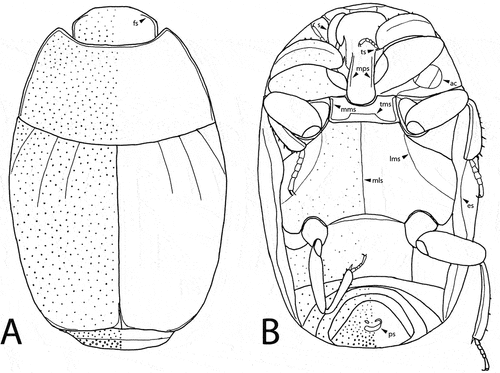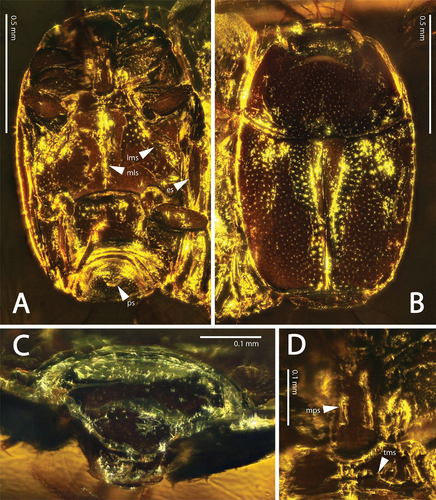ABSTRACT
We describe the first fossil species of the extant genus Eulomalus (Coleoptera: Histeridae: Dendrophilinae: Paromalini) from the Eocene Baltic amber. Eulomalus balticus sp. nov. has a flattened body shape typical for the Histeridae living under the bark of decaying trees. The newly described species is the only European representative of the genus, which is presently distributed chiefly in the Indomalayan realm.
http://urn:lsid:zoobank.org:pub:7D6209FE-5D98-4580-9CF6-E409CA27E536
Introduction
The genus Eulomalus Cooman, Citation1937 was described based on a number of characters: frontal stria anteriorly incomplete; labrum long and narrow, protruding from clypeus; meso- and metatibial spines diminishing in size basally; body shape slightly oval, not parallel-sided and a single pair of labral setae present (Cooman Citation1937). Currently, the genus contains 28 described species native mainly to the Indomalayan realm, with several species distributed also in the Australasian and East Palearctic Regions (South Korea, Japan) (Mazur Citation2011; Seung and Lee Citation2019).
Hitherto, there have been seven described histerid species known from the Palaeogene deposits (Baltic amber, Rovno amber, Quercy, France and Céreste, France). They represent the subfamilies Abraeinae, Dendrophilinae, Histerinae and Onthophilinae (Handschin Citation1944; Alekseev Citation2016; Dégallier et al. Citation2019; Sokolov and Perkovsky Citation2020; Alekseev and Bukejs Citation2021a, Citation2021b). For the summary of all fossil Histeridae, see Simon Pražák et al. (Citation2023). Four species of Histeridae have been described from the Baltic amber so far (see ). They are all examples of clown beetles’ taxa typically associated with dead wood (Kryzhanovskij and Reichardt Citation1976; Kovarik and Caterino Citation2016). Eulomalus balticus sp. nov., with its strongly flattened body shape typical for clown beetles that dwell under bark of decaying fallen trees, is not an exception.
Table 1. Histeridae described from Baltic amber.
Material and methods
The amber inclusion was purchased on ambertreasure4u.com. The inclusion was cut with Dremel Work Station 220 (cutoffs are stored together with the type specimen) and polished with 600 and 1200 wet sand papers. Final polishing was done with toothpaste. Observation of morphological characters was done using a Leica S9D binocular microscope. Specimens were photographed with Canon EOS 550 mounted on Olympus BX40 with Mplan and LUCPlanFLN lenses. The original photographs were processed using Adobe Photoshop CS4 (Adobe Systems Inc.), and for some images, the focus-stacking software Zerene Stacker (Zerene Systems LLC).
Classification and nomenclature follow Mazur (Citation2011). Terminology is used according to Ôhara (Citation1994).
The holotype is stored at the Museum of Eastern Bohemia, Hradec Králové, Czech Republic, under the inventory number xxx (will be completed once the MS is accepted). The publication and the included nomenclatural acts have been registered in ZooBank (www.zoobank.org), the online registration system for the ICZN. The LSID for this publication is: urn:lsid:zoobank.org:pub:xxx (will be completed once the MS is accepted).
Systematic palaeontology
Subfamily Dendrophilinae Reitter, 1909
Tribe Paromalini Reitter, 1909
Genus Eulomalus Cooman, Citation1937
Eulomalus balticus Simon-Pražák & Lackner sp. nov. (
LSID urn:lsid:zoobank.org:act:8A7BAADB-1325-48CA-A3FE-6FC901D617AF
Type material
Holotype, female – based on the presence of pygidial sculpture (Zhang and Zhou Citation2007), amber resin clear without synclusions, dimensions 0.9 × 0.4 cm.
Type locality and age
Baltic amber, Yantarny mine, Kaliningrad region, Russian Federation, late Eocene: Priabonian (34 to 38 Mya) (Sadowski et al. Citation2020).
Measurements
Head width: 0.33 mm, width between anterior pronotal angles: 0.35 mm, width between posterior pronotal angles: 0.68 mm, pronotal length: 0.36 mm, elytral length: 0.62 mm, elytral width (across widest point): 0.74 mm.
Body
Strongly dorsoventrally flattened, slightly elongate, oval. Colour reddish brown to black. Dorsally and partially also ventrally very finely and sparsely punctate (punctures about 50 microns across), otherwise smooth and shiny.
Head
Capsule wide, frons and clypeus flat, smooth and shiny, with delicate and scarce punctures separated by at least six times of their diameter. Frontal stria present, interrupted anteriorly; clypeolabral suture not visible. Labrum trapezoidal, not well visible. Head retracted, remaining mouthparts not observable. Scape long and curved, antennal club round and flattened, with two visible annuli. Rest of the antennae hardly observable.
Thorax
Pronotum shiny, with small punctures widely separated from each other (similar to frons). Basal pronotal margin widely arcuate, straight medially. Scutellar shield invisible. Elytra with scattered punctuation, punctures slightly larger in apical half. Elytral disc anteromedially depressed, sutural area elevated, forming a keel. Elytra with short and faint rudiments of three dorsal striae. Elytral epipleural stria present, complete. Prosternal lobe short, widely rounded anteriorly. Prosternum impunctate. Marginal prosternal stria clearly visible. Mesoventrite trapezoidal, emarginate on anterior margin. Marginal mesoventral striae present, anteriorly outwardly curved. Mesoventral disc with a transverse stria with two rectangular angles, medially straight. Metaventrite finely punctured; medially with a longitudinal stria. Lateral metaventral stria running latero-posterad, extending to metepisternum. Postmesocoxal sutures present, curved along mesocoxae.
Abdomen
First visible abdominal ventrite with punctures only along anterior margin. Propygidium finely punctate. Pygidial punctuation denser, punctures separated by 2–3 times of their diameter. Pygidium with an irregular depression .
Legs
Profemur wide, flattened. Protibia wide, smooth along outer margin, with four minuscule denticles. Protarsus simple, protarsomere V as long as protarsomeres II–IV combined. Mesofemur wide, mesotibia relatively slender, with thick setae along its outer margin diminishing in size basally. Metafemur wide and robust, metatibia slender with setae along outer margin diminishing in size basally. Meso- and metatarsus as in front leg.
Taxonomic assignment
The species can be clearly placed within the Paromalini tribe (Histeridae: Dendrophilinae) based on the following diagnostic traits: prosternal lobe short and wide, antennal cavities located postero-laterally and weakly defined, posterior prosternal margin rounded and projecting backwards, broad and wide protibia with an apical spur. We assign the species to the genus Eulomalus Cooman, Citation1937 based on the combination of the following characters (): frontal stria interrupted medially, presence of irregular depressions on pygidium, meso- and metatibiae dilated with spines along outer margin diminishing in size basally, shape of mesoventral transverse stria, lateral metaventral stria running postero-laterad (Cooman Citation1937; Zhang and Zhou Citation2007).
Figure 2. Eulomalus balticus sp. nov. A – dorsal view (fs = frontal stria); B – ventral view (ac = antennal club, es = epipleural stria, lms = lateral metaventral stria, mls = median longitudinal stria, mms = marginal mesoventral stria, mps = marginal prosternal striae, ps = pygidial sculpture, s = scape, tms = transverse mesoventral stria).

Differential diagnosis
We compared Eulomalus balticus with descriptions of other congeners (Marseul Citation1864, Citation1870, Citation1879; Lewis Citation1892; Blackburn Citation1892; Lea Citation1925; Reichardt Citation1932; Cooman Citation1937, Citation1941; Thérond Citation1965; Zhang and Zhou Citation2007; Seung and Lee Citation2019). Eulomalus balticus can be distinguished from all of them by the combination of these characters: presence of median longitudinal stria on metaventrite, presence of epipleural stria, shape of the lateral mesoventral striae (curved outwards anteriorly), shape of the female pygidial sculpture and presence of three faint rudiments of dorsal striae.
Etymology
Specific name refers to the deposit of the fossil – Baltic amber.
Discussion
Eulomalus balticus sp. nov. is the first fossil representative of the genus. Along with other described species of Histeridae from the Eocene, it is a wood-associated clown beetle, typical for the forest ecosystems of Eocene Europe (Alekseev and Alekseev Citation2016). Eulomalus balticus presumably inhabited subcortical spaces of dead trees, similar to its extant congeners (Kryzhanovskij and Reichardt Citation1976). Subcortical strategy in Histeridae has been reported as early as mid-Cretaceous, during which era this way of life existed in at least two separate lineages – Dendrophilinae and Histerinae (Caterino Citation2021; Simon Pražák et al. Citation2023). Extant species of Eulomalus are distributed mostly in the Eastern Palearctic, Indomalayan and Australasian Regions. The discovery of Eulomalus from the late Eocene deposits in Europe considerably stretches the genus’ known range and indicates its wider distribution in the past.
Acknowledgments
We thank three anonymous reviewers for their helpful comments and suggestions. The work of JSP and JP was supported by the Grant Agency of the Czech Republic under grant 21-05216S.
Disclosure statement
No potential conflict of interest was reported by the author(s).
Additional information
Funding
References
- Alekseev VI. 2016. Description of two clown beetles (Coleoptera: Staphyliniformia: Hydrophiloidea: Histeridae) from Baltic amber (Cenozoic, Paleogene, Eocene). Balt J Coleopterol. 16(1):27–35.
- Alekseev VI, Alekseev PI. 2016. New approaches for reconstruction of the ecosystem of an Eocene amber forest. Biol Bull. 43(1):75–86. doi:10.1134/S1062359016010027.
- Alekseev VI, Bukejs A. 2021a. A new Eocene Bacanius species (Histeridae: Dendrophilinae) from Baltic amber. Foss Rec. 24(1):93–99. doi:10.5194/fr-24-93-2021.
- Alekseev VI, Bukejs A. 2021b. The first extinct species of Acritus LeConte, 1853 (Histeridae: Abraeinae) from Eocene Baltic amber: a microscopic beetle inclusion studied with X-ray micro-computed tomography. Foss Rec. 24(2):223–231. doi:10.5194/fr-24-223-2021.
- Blackburn T. 1892. Further notes on Australian Coleoptera, with descriptions of new genera and species. Trans R Soc S Aust. 15:20–73.
- Caterino MS. 2021. New fossil histerid species from Cretaceous Burmese amber (Coleoptera: Histeridae). Coleopt Bull. 75(1):211–221. doi:10.1649/0010-065X-75.1.211.
- Cooman A. 1937. Étude sur les genres Paromalus Er. et Eulomalus n. g. (Col. Histeridae). Notes Entomol Chin. 4:89–167.
- Cooman A. 1941. Coléopteres Histeridae d’Extrême-Orient, principalement du Tonkin. Notes Entomol Chin. 8:291–333.
- Dégallier N, Garrouste R, Nel A. 2019. New and poorly known Cenozoic clown beetle compressions from France (Insecta: Coleoptera: Histeridae). Ann Soc Entomol Fr. 55(6):471–481. doi:10.1080/00379271.2019.1688683.
- Handschin E. 1944. Insekten aus den Phosphoriten des Quercy. Sch Pal Ab. 64:1–23.
- Kovarik PW, Caterino MS. 2016. 13.3 Histeridae Gyllenhal, 1808. In: Beutel RG, Leschen RAB, editors. Handbook of zoology: Coleoptera, Beetles Morphology and Systematics. Archostemata, Myxophaga and Polyphaga Partim. 2nd ed. Vol. 1. Berlin: Walter De Gruyter; p. 273–314.
- Kryzhanovskij OL, Reichardt AN. 1976. Zhuki nadsemejstva histeroidea (semejstva sphaeritidae, histeridae, synteliidae) [beetles of the superfamily histeroidea (families sphaeritidae, histeridae, synteliidae] Scarlato OA editor Fauna SSSR, Zhestokrylve, Vypusk 4. Russian Leningrad: Nauka, p. 434.
- Lea AM. 1925. On Australian Histeridae (Coleoptera). Trans Entomol Soc Lond. 57:239–263.
- Lewis G. 1892. On some new species of Histeridæ. Ann Mag Nat Hist. 9(6):341–357. doi:10.1080/00222939208677336.
- Marseul SA. 1864. Histérides de l’Archipel Malais ou Indo-Australien. L’Abeille. 1:271–341.
- Marseul SA. 1870. Description d’espèces nouvelles d’histérides. Ann Soc Entomol Belg. 13:55–158.
- Marseul SA. 1879. Enumération des histérides, rapportés de l’Archipel Malais, de la Nouvelle Guinée et de l’Australie boréale par MM, le prof. O. Beccari et L.M. D’Alberti. Ann Mus Civ Stor Nat Genova. 14:254–286.
- Mazur S. 2011. A concise catalogue of the Histeridae (Coleoptera). Warsaw: Warsaw University of Life Sciences – SGGW Press; p. 332.
- Ôhara M. 1994. A Revision of the superfamily histeroidea of Japan [Coleoptera]. Insecta Matsumurana. 51:1–283.
- Pražák J S, Fikáček M, Prokop J, Lackner T Under the Cretaceous bark: Fossil evidence for the ancient origin of subcortical lifestyle of clown beetles (Coleoptera: Histeridae). Arthropod Syst Phylo. 2023;81:439–453.
- Reichardt A. 1932. Liste des histérides, racoltés en 1930 à Ténasserim par le Dr J W Helfer et conservés au Muséum National de Prague. Acta Entomol Mus Nat Pragae. 10:113–124.
- Sadowski EM, Schmidt AR, Denk T. 2020. Staminate inflorescences with in situ pollen from Eocene Baltic amber reveal high diversity in Fagaceae (oak family). Willdenowia. 50(3):405–517. doi:10.3372/wi.50.50303.
- Seung J, Lee S. 2019. Two new species of Genus Eulomalus Cooman, 1937 (Coleoptera: Histeridae) from Korea. J Asia Pac. 12(2):186–190. doi:10.1016/j.japb.2019.02.003.
- Sokolov AV, Perkovsky EE. 2020. The first Eocene species of Bacanius (Coleoptera: Histeridae: Dendrophilinae) from Rovno Amber. Russ Entomol J. 29(2):157–160. doi:10.15298/rusentj.29.2.06.
- Thérond PJ. 1965. Quatre espéces nouvelles de coléoptères – histeridae, originaires de la Nouvelle-Guinée, dans les collections du Musée Hongrois d’Histoire Naturelle. Ann Hist Nat Mus Nat Hung. 57:269–271.
- Zhang YJ, Zhou HZ. 2007. Taxonomy of the tribe Paromalini Reitter (Coleoptera: Histeridae, Dendrophilinae) from China. Zootaxa. 40(1544):1–40.

